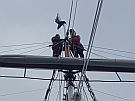aft
Towards the stern (rear) of the ship.
barquentine
A sailing vessel with three or more masts; with a square rigged foremast and fore-and-aft rigged main, mizzen and any other masts.
beam reach
When the wind is at a right angle to the sailing craft. The wind is coming across the boat at a right angle to the centerline, the relative bearing would be 3 o'clock or 9 o'clock.
bearing marker
The direction of a distant object relative to the current course.
boom
A spar (pole) that supports the foot of the mainsail.
bow
Forward part of the hull of a boat or ship.
broad reach
The wind is coming from behind the sailing craft at an angle; at a relative bearing of about 4 o'clock or 8 o'clock.
close hauled
The closest to the wind that boats can efficiently sail and is usually a relative bearing of 1 o'clock or 11 o'clock. On this point of sail the sails are brought in as close to the centerline of the boat as possible.
close reach
The wind is coming from ahead of the boat with a relative bearing of 2 o'clock or 10 o'clock. The fastest point of sail for most boats.
downwind
The direction that the wind is moving.
fore
Located at or toward the front of the boat; forward.
hauora
Well-being - includes the physical, mental and emotional, social, and spiritual dimensions of health.
helm
Take control of (verb). Part that steers a ship/boat (noun).
Hinemoana
The ocean is known as the Moana nui a Kiwa, the Great Ocean of Kiwa, but is actually personified in Hinemoana, the Ocean Maid.
Hinenui te Pō
Goddess of night and death and the ruler of the underworld in Māori mythology. She is a daughter of Tāne. The red colour of sunset comes from her.
hoist (sails)
To raise/put up.
hull
The main part of a ship or boat.
in irons
A sailing craft is said to be "in irons" if it is stopped with its sails unable to generate power in the no-go zone.
jib
Sail near the bow (front) of a sailing vessel.
ketch
A sailing vessel with two masts; a tall mainmast and a mizzen.
lashing
Using ropes for tying, wrapping or connecting things.
line
On board a boat, this is what you say instead of “ropes" and includes all ropes, cables and cordage. The only rope is the anchor rope (which can also be a chain).
mainsail
The largest sail on a sailing vessel.
mast
Any vertical pole for supporting sails, rigging, flags, etc, above the deck of a vessel.
mizzen
The sail aft (towards the rear) of a sailing vessel.
nautical mile
A unit of distance equal to 1,852 metres that is used for sea and air travel.
navigator
A person who plans how to reach a destination.
no-go zone
Sailing craft cannot sail directly into the wind, nor on a course that is too close to the direction from which the wind is blowing.
ocean current
A continuous flow of water in the ocean.
ocean swells
Rolling waves that travel long distances through the ocean.
outrigger
A part that is attached to the side of a boat or canoe to keep it from turning over in the water.
passage planning
Setting the course to a destination.
points of sail
The angle a boat sails at. Close hauled (beating), close reach, beam reach, broad reach, and run; as in: Sailing a full circle we will cover all the points of sail.
quartermaster
Person in charge of steering a ship and the use of signals on a ship.
reaching
When the wind is coming from the side of the sailing craft, this is called reaching.
rigging
Rigging is the name for the system of wire cables and ropes that both support the sails and allow them to be controlled.
running
A point of sail where the wind is coming from directly behind the boat. Directly downwind with the sails let out at right angles to the centerline of the boat. The wind is at a relative bearing of 6 o'clock.
sailor
A person who works on a boat or ship as part of the crew.
skipper
Master of a ship/boat.
schooner
A boat with two or more masts, the forward of which is the same height or shorter than the after.
sloop
A one-masted sailing boat with a mainsail and jib rigged fore and aft.
spar
A pole of wood, metal or lightweight materials such as carbon fibre used in the rigging of a sailing vessel to carry or support its sail.
square rig
A sailing ship with large square sails. These primary driving sails are carried on horizontal spars
steering hoe
Paddle used to steer a waka.
stern
The back of the boat
Taha hinengaro
Mental and emotional well-being.
Taha tinana
Physical well-being.
Taha wairua
Spiritual well-being.
Taha whānau
Social well-being.
tiller
A lever used to turn the rudder of a boat from side to side.
trim
Adjust the sails so they catch the wind properly.
upwind
The direction opposite to where the wind is blowing.
watch
Members of the crew are assigned to keep watch over the ship while at anchor. In practice they monitor the position of the ship to detect movement of the anchor and alert to crew to any problems.
watch captain
Watch captains are responsible for communicating the rules of the sea to the crew and making sure the crew are sailing the correct course. Watch captains help skipper the waka, allowing the skipper to rest when needed.
wayfinding
Another name for traditional navigation, without the use of modern instruments.




